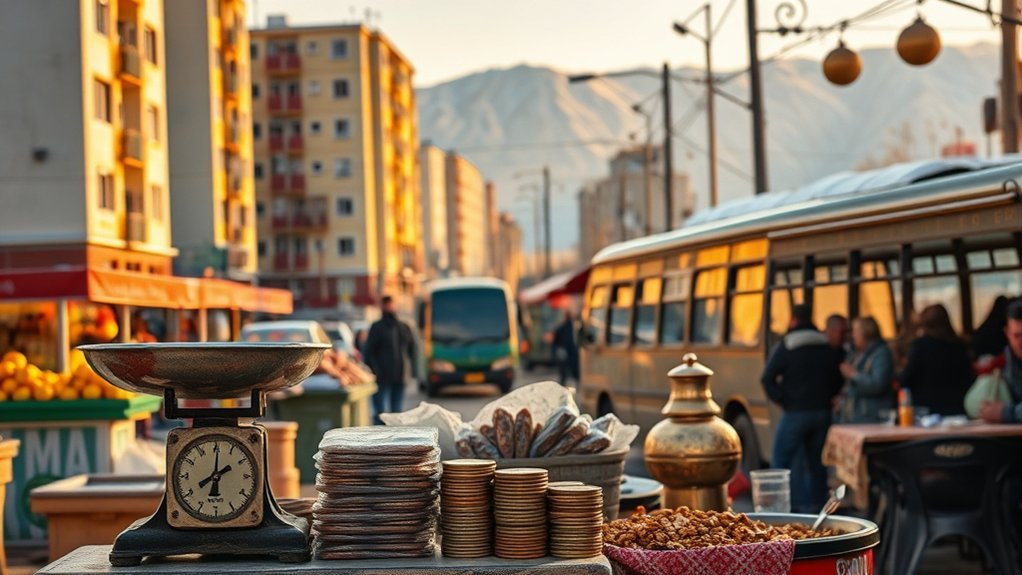You can live modestly in Kyrgyzstan for about $600–700 a month, with typical monthly expenses around $663 covering rent, utilities, food and transport. Expect city-center one-bed rents near $484, cheaper utilities about $23, internet $11.70, and public transport passes around $11.90. Groceries and meals are much lower than U.S. levels, while average after-tax salary sits near $390. Keep reading and you’ll find detailed breakdowns and saving strategies to plan your budget.
Overview of Kyrgyzstan’s Cost of Living
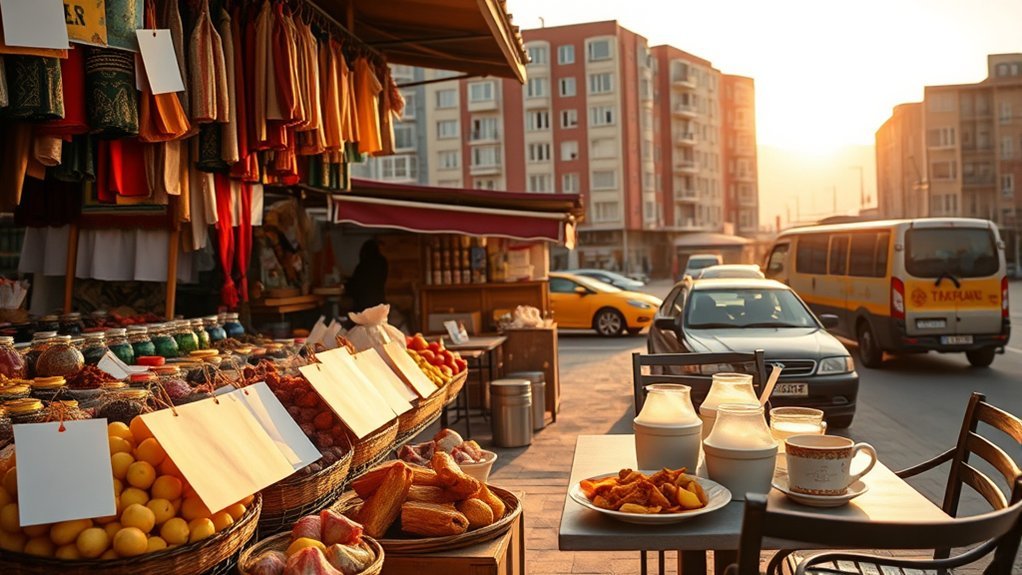
Although Kyrgyzstan has modest incomes, its low prices make daily life affordable: the typical monthly cost of living is about $663, roughly 1.72 times cheaper than the world average, while the average after-tax salary sits near $415.
You’ll find the country ranks 153rd out of 197 for cost of living, which quantifies its relative affordability. On a basic budget you’ll allocate roughly $23.20 monthly for utilities, a small but consistent essential expense.
Rent is significantly lower than Western benchmarks—city-center one-bedroom averages $410—so your discretionary spending can cover food, transport, and modest leisure after fixed costs.
With income below the monthly cost, you’ll likely need supplemental funds if you want savings or higher consumption. For budgeting, prioritize predictable bills, track local price indices, and adjust monthly allocations so essential services, groceries, and occasional transport fit within realistic after-tax income scenarios.
This data-driven view helps you plan sustainable living.
Housing and Rent Prices by City
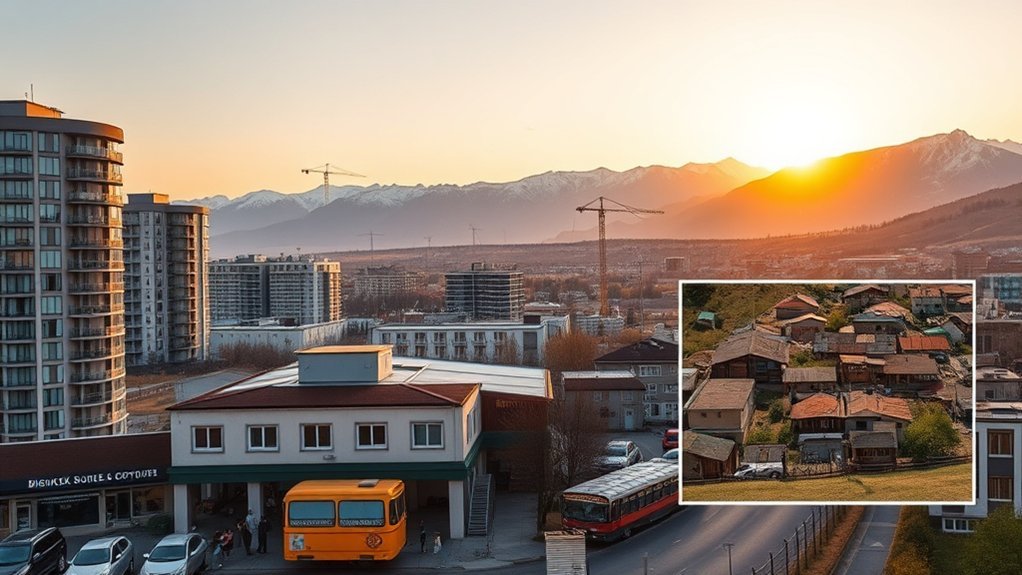
When you compare city-center rents, Kyrgyzstan looks inexpensive: a one-bedroom in central areas averages about $484.10 monthly, roughly 72% cheaper than U.S. averages and 87.1% lower than New York City rates in Bishkek. You’ll find housing costs are clearly budget-friendly relative to international benchmarks, but you should weigh them against the average monthly salary after tax of $390.20. For larger households, a three-bedroom outside the center averages $620.50, far below the U.S. $2,396.80.
| City/Type | Typical Rent (USD) | Comparison |
|---|---|---|
| Bishkek — 1BR center | $484.10 | 87.1% below NYC |
| Outside center — 3BR | $620.50 | Much lower than US |
| National average salary | $390.20 | Rent-to-income pressure |
You’ll use these figures to plan realistic budgets, prioritize neighborhoods, and decide if rent prices align with your income and lifestyle expectations.
Utilities, Internet, and Monthly Bills

You’ll want to break down typical utilities—electricity, gas, water—into line items, since the average single-person bill runs about $23.2 monthly.
A 915 sq ft apartment can cost 2,000–6,800 KGS depending on use.
Plan for reliable internet at roughly $11.7 per month for 50 Mbps+, and factor in that monthly totals can shift with policy or market moves and high mortgage rates (≈20.15% for a 20-year fixed) that affect housing budgets.
Use these figures to build a monthly bill forecast and test scenarios for low, average, and high consumption.
Typical Utility Breakdown
One clear starting point for budgeting is the average monthly utility bill: for one person in Kyrgyzstan it’s about $23.20, which covers essential services like electricity, gas, and water.
In a typical utility breakdown you’ll see that per-person costs are low compared with many countries, but scale quickly with apartment size and consumption. For a 915 sq ft unit, basic utilities can reach roughly $3,521.54 annually (about $293.46 monthly), depending on usage and local tariffs.
That gap shows why you should model both per-person and per-dwelling scenarios. Include contingency for seasonal heating and variable water use.
Exclude internet from this section; treat it separately. Use these figures to project monthly and annual household budgets accurately.
Internet Speeds and Costs
After you’ve modeled per-person and per-dwelling utility scenarios, factor internet into your monthly bill calculations: a plan with 60 Mbps or more averages about $11.70 per month in Kyrgyzstan, adding roughly 3% to the average net monthly salary of $390.20 and about 50% to a single person’s basic $23.20 utilities line.
You’ll find internet costs are low compared with Western markets, so you can allocate more of your budget elsewhere while maintaining reliable connectivity.
Consider these quick benchmarks to decide what to buy:
- 60 Mbps plan — $11.70/month: baseline for streaming and remote work.
- Utilities (single) — $23.20/month: internet increases this by ~50%.
- Salary impact — $11.70 is ~3% of $390.20: minimal strain.
Use these figures to make data-driven tradeoffs.
Monthly Bill Budgeting
Although utilities and internet together can form a predictable monthly envelope, you should budget them precisely: expect about $23.20 for a single person’s basic utilities and an additional $11.70 for a 60 Mbps plan, meaning internet raises that utilities line by roughly 50% and represents about 3% of the cited average net salary—so allocate ~$35 per month for essentials if you’re living alone, and scale up proportionally for larger households or a 915 sq ft apartment whose bills can reach much higher levels depending on consumption.
| Item | Typical monthly cost |
|---|---|
| Single-person utilities | $23.20 |
| 60 Mbps internet | $11.70 |
| Essentials subtotal (single) | ~$35.00 |
| Large apartment potential | $3,521.54 |
When you build a monthly budget, track consumption, seasonality, and provider fees to avoid surprises.
Grocery Prices and Typical Food Costs

You’ll find basic staples in Kyrgyzstan are budget-friendly: a liter of milk is about $0.87, a 0.5 kg loaf of white bread $0.65, 12 eggs $1.80, rice $1.60/kg, and chicken fillets $4.75/kg.
Compared with U.S. averages, those items are roughly 12–86% cheaper, which can cut your monthly grocery bill substantially if you cook at home.
For eating out, expect low-cost local meals to undercut Western-style restaurants, so plan meal budgets around frequent home cooking supplemented by inexpensive street or cafe options.
Typical Grocery Staples
Groceries in Kyrgyzstan are particularly budget-friendly: a liter of milk costs about $0.87 (≈11.7% cheaper than the U.S.), a 0.5 kg loaf of white bread runs roughly $0.65 (about 86.5% less), and chicken breast is around $4.75 per kg (58.5% below U.S. levels).
You’ll find typical grocery staples priced to stretch a budget while maintaining basic nutrition. Focus on staples for low-cost meal planning.
- Rice — $1.60/kg (≈65.5% cheaper than U.S.); good for bulk meals.
- Eggs — $1.80/dozen (≈56.8% lower); versatile protein.
- Bread — $0.65/0.5 kg; ideal for daily consumption.
Using local markets and buying staples in quantity, you can keep weekly grocery costs significantly lower than in Western countries without sacrificing variety.
Eating Out Comparisons
When you compare eating out in Kyrgyzstan to the U.S., the numbers show clear savings: a cheap restaurant meal or a McDonald’s combo runs about $5.80 (roughly 70.8% and 46.9% cheaper than U.S. equivalents).
A mid-range three-course dinner for two is just $19.90 (about 73.5% less). A 0.5 L local beer costs ~$1.20 (80.5% lower), and a cappuccino averages $2.10 (60.5% cheaper).
So dining choices—from fast food to casual sit-downs and coffee—let you stretch a modest food budget without sacrificing variety.
You can plan weekly eating out budgets precisely: frequent cheap meals at $5.80, occasional mid-range dinners at $19.90, and coffee or beer habits at $2.10 and $1.20 respectively.
Eating Out and Entertainment Expenses

Although Kyrgyzstan’s restaurants and cafés feel modest, they’ll stretch your food budget: a cheap meal runs about $5.80 (70.8% cheaper than the U.S. $20 average), a three-course mid-range dinner for two is roughly $19.90 (73.5% below the U.S. $75), and a fast-food combo sits near $5.80 versus $11 in the U.S.; drinks are also inexpensive — local beer (0.5 L) about $1.20 (80.5% cheaper than the U.S. $6) and a cappuccino roughly $2.10 (60.5% lower than the U.S. $5.20) — so you can plan predictable, low-cost dining without sacrificing variety.
Modest cafés and restaurants stretch your food budget — cheap meals, cheap drinks, and predictable low-cost dining.
You’ll find eating out keeps entertainment spending modest: cinema tickets, small live-music venues and casual bars generally mirror food prices. To plan a monthly budget, consider these typical choices:
- Two cheap restaurant meals per week for a month: ~$46.40.
- One mid-range dinner for two monthly: ~$19.90.
- Four coffees per week for a month: ~$33.60.
This data-driven snapshot shows how eating out and casual entertainment fit into a tight, controllable budget.
Transportation and Commuting Costs

Now let’s look at transportation and commuting costs so you can budget precisely.
A single local-transport ticket runs about $0.20 (roughly 90.7% cheaper than the U.S. $2.50), while a monthly pass is near $11.90 (about 81.7% less than the U.S. $65).
Taxis start around $1.40 with $0.20/km, and gasoline is ≈$0.80/L, so factor much lower per-trip and fuel expenses compared with U.S. rates.
Local Transport Fares
If you rely on public and hired transport in Kyrgyzstan, you’ll find commuting very affordable: a one-way local ticket runs about $0.20 (90.7% cheaper than the U.S. $2.50), a monthly pass is roughly $11.90 (about 81.7% below the U.S. $65 average), taxi base fares start near $1.40 (62.6% lower than the U.S. $3.80), and per-kilometer taxi charges are about $0.20 versus $1.70 in the U.S. (an 86.6% reduction); fuel is also modest at ~$0.80/L compared with ~$0.90/L in the U.S. (12.7% lower).
So whether you buy tickets, a pass, or use taxis, your daily transport budget in Kyrgyzstan will be a small fraction of typical U.S. commuting costs.
- Compare costs: single ticket $0.20, monthly $11.90.
- Taxi economics: $1.40 base, $0.20/km.
- Fuel: ~$0.80 per liter.
Taxi and Ride‑Hailing
Ride-hailing and taxi trips in Kyrgyzstan are extremely budget-friendly: expect a typical flag drop around $1.40 and incremental charges near $0.20 per kilometer.
So short rides cost only a few dollars and even longer trips remain far cheaper than in the U.S. (flag drops there average $3.80 and $1.70/km).
You’ll find taxi apps and street taxis both follow this pricing, so you can optimize costs by comparing fares before booking.
For routine commuting, weigh a monthly transport pass at $11.90 against frequent taxi use; the pass is a low-risk, predictable expense.
Data-driven travelers calculate trips: a 5 km taxi costs about $2.40, still substantially below U.S. equivalents, making taxis an affordable option for occasional convenience.
Fuel and Vehicle Costs
Because fuel and vehicle expenses shape your daily budget, it’s worth noting that gasoline in Kyrgyzstan runs about $0.80 per liter—roughly 12.7% cheaper than the U.S.—so refueling is consistently less costly.
You’ll find overall transportation cheaper: local one-way fares are $0.20, monthly passes $11.90, and taxis start at $1.40 with per-kilometer rates near $0.20.
These figures lower your ongoing vehicle costs and make car ownership and commuting affordable.
- Compare: fuel price $0.80/L vs U.S. average — 12.7% savings.
- Commuting: one-way $0.20; monthly pass $11.90 — 81.7% cheaper than U.S. monthly.
- Taxis: start $1.40; $0.20/km — favorable for short trips.
Use these metrics to forecast monthly transport spending precisely.
Healthcare and Insurance Costs

Healthcare in Kyrgyzstan is generally affordable: a typical doctor’s consultation runs about $15, public facilities charge low fees, and common prescription drugs often cost under $10.
For budget planning, note that healthcare services in Kyrgyzstan split between low-cost public clinics and higher-priced private clinics favored by expats for quality and English-speaking staff. You’ll pay roughly $15 per GP visit in private settings and similar or less in public hospitals.
Expect to spend $500–$1,500 annually for expatriate health insurance, depending on emergency coverage, evacuation, and inpatient limits. Factor in occasional specialist visits, diagnostics, or private hospital stays that can raise out-of-pocket costs.
Prescription meds for routine conditions usually stay under $10 per item, which keeps ongoing drug expenses modest. To minimize financial risk, choose a plan covering emergency services and evacuation; compare providers by annual premium, coverage ceiling, and co-pay structure so you can predict yearly healthcare spending accurately.
Salaries, Purchasing Power, and Employment
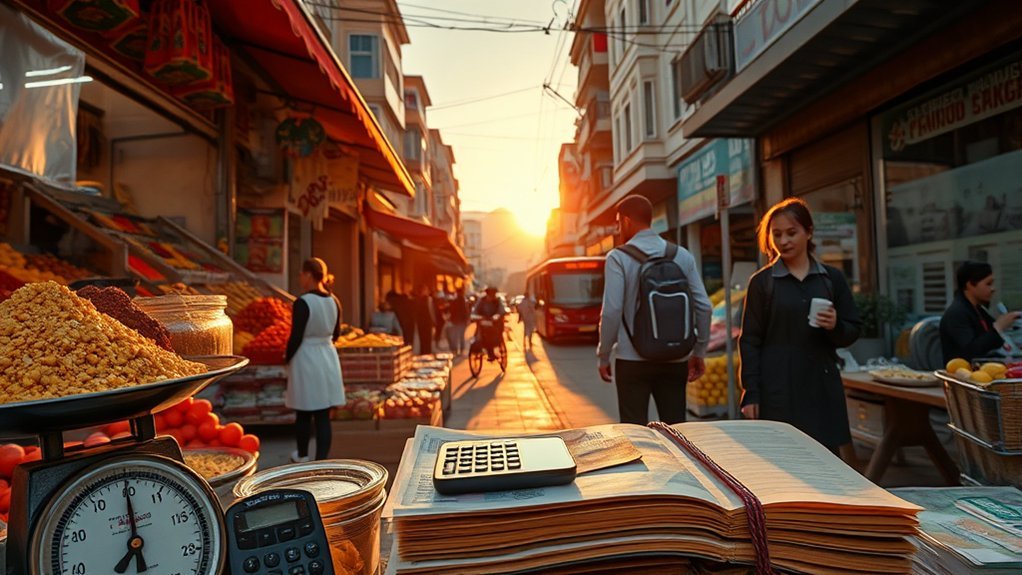
How far will your paycheck go in Kyrgyzstan? You’ll need tight budgeting: average monthly salaries after tax are about $390.2, versus $4,336.8 in the U.S., so purchasing power and choices differ sharply.
Consider these quick metrics:
- GDP per capita: $2,419 — a baseline for national income and economic productivity.
- Cost of living: ~63.4% cheaper (including rent) — reduces expenses but not proportionally to wage gaps.
- Coverage by salary: roughly 0.6 months of living expenses on an average wage — signaling shortfalls for many households.
Given a human freedom index of 6.57, job availability and conditions can vary; you’ll likely face informal work or lower-paid sectors.
With a human freedom index of 6.57, employment is uneven—expect informal work and lower-paid jobs for many.
Plan for irregular income, prioritize essentials, and build emergency savings. If you want a secure lifestyle, aim for higher-skilled roles, dual incomes, or remote work to bridge the disparity between local salaries and necessary spending.
Education, Childcare, and School Fees
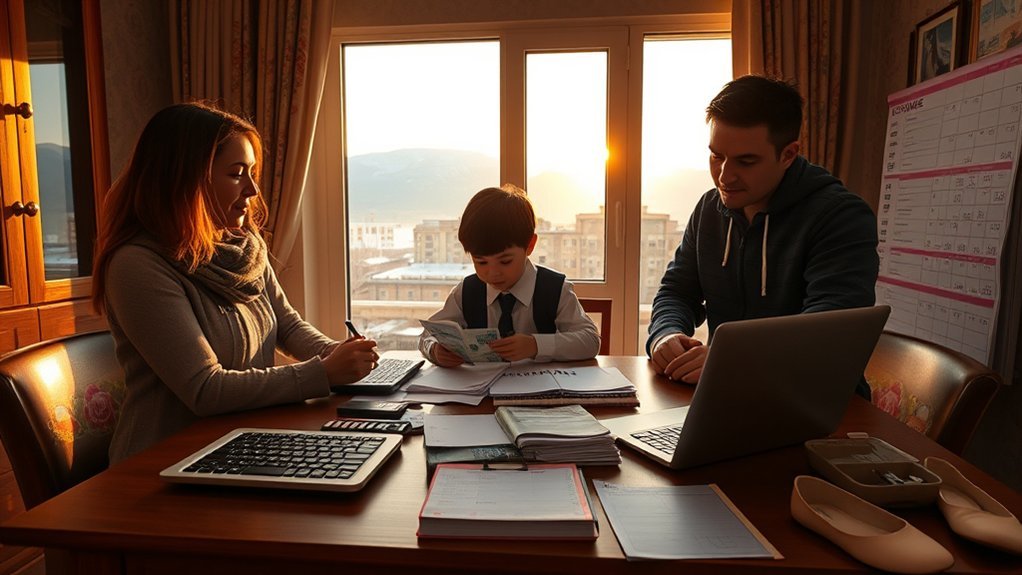
Education and childcare costs in Kyrgyzstan can strain a typical household budget: with the average after-tax monthly salary around 38,361 KGS, a full-day private preschool averaging 18,083 KGS per month would consume nearly half that income for one child, while international primary school fees average about 487,143 KGS per year (range 270,000–700,000 KGS), translating to a substantial monthly outlay if you opt in.
You’ll need to budget precisely: preschool ranges 10,000–25,000 KGS monthly, so two children can quickly eclipse a single salary. International school tuition breaks down to roughly 40,595 KGS monthly at the mean, exceeding average net pay.
Factor in extracurriculars—an adult fitness club membership averages 4,179 KGS monthly—and occasional leisure like cinema at ~435 KGS per ticket.
When planning household expenses, allocate separate line items for education, childcare, and school fees, model worst- and best-case fee scenarios, and compare them against net income to assess affordability before committing.
Tips for Saving Money and Managing Finances
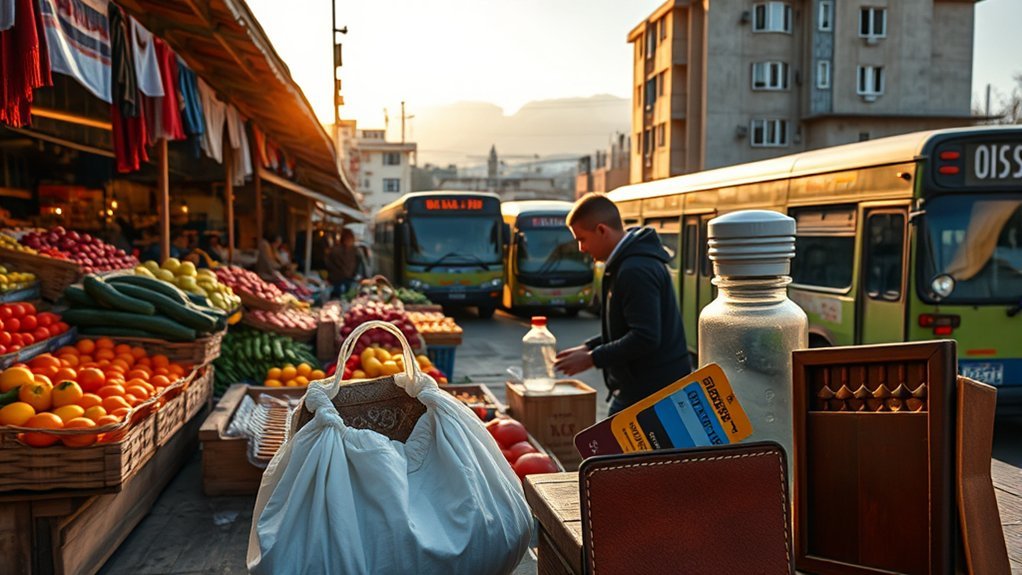
Because everyday costs in Kyrgyzstan are generally lower than in Western countries, you can stretch your budget materially by prioritizing local options and tracking expenses, starting with transport and utilities: a one-way local bus fare is only $0.21 (about 90.7% cheaper than the U.S. average of $2.50), and utilities average roughly $23.20 per month for an individual—both predictable line items you can optimize.
Everyday costs in Kyrgyzstan are low—opt local transport, track utilities, and stretch your budget effectively.
Further savings come from choosing local restaurants (meal for two ≈ $19.90), shopping staples like milk at $0.87/L and bread at $0.65, and targeting city-center one-bedroom rentals around $410/month when housing quality and commute align with your needs.
Use these targeted tactics to manage finances efficiently and build predictable monthly budgets focused on actual living costs. Apply a simple rule: optimize high-frequency, low-cost items first.
Key actions to implement:
- Track weekly transport, groceries, and utilities to identify waste.
- Prioritize local markets and restaurants to reduce food line items.
- Choose housing that balances rent, commute time, and utility costs to minimize total monthly spend.
Frequently Asked Questions
What Is the Cost of Living in Kyrgyzstan per Month?
You’ll spend about $489.3 monthly expenses as a single person (excluding rent) and about $1,759.8 for a family of four; expect rent ~ $410 for a city one-bedroom, with average salary covering ~0.6 months.
Is Kyrgyzstan Cheap or Expensive?
You’ll find Kyrgyzstan is cheap — investigating Affordability Comparison shows rent ~72.2% lower, overall cost ~59.1% lower than the U.S.; you’ll save on utilities (~$23/month) and meals (~$5.80), maximizing a tight budget.
Can Foreigners Live in Kyrgyzstan?
Yes — you can live in Kyrgyzstan: Residency options include tourist, business, and work visas; you’ll evaluate legal requirements, language barriers, and budget constraints against average net salary (~$415), prioritizing affordable rent and living costs.
Is Kyrgyzstan a Good Place to Live?
Ironically, yes — you’ll love Kyrgyzstan if you value affordable living and rich Cultural Experience. With monthly wages around $415, housing about $410, and 59% lower costs than the U.S., you’ll budget tightly yet enjoyably.
Conclusion
You’ll smile at Kyrgyzstan’s modest price tags — $200–$400 rent in Bishkek versus $80 in smaller towns — and wonder how your latte-addicted budget survived. Utilities, $30–$70; groceries for one, $120–$200; a doctor visit, $5–$20. Your paycheck might be modest, but your purchasing power stretches; saving feels almost accidental when meals cost a fraction of home. Ironically, frugal choices here look indulgent on your travel spreadsheet.

